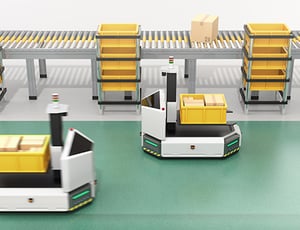 It is expected the logistics industry will adopt self-driving vehicles much faster than most other industries. The primary concern for automated motorized vehicles is personnel and property damage liability. Secure areas and minimal personnel mitigate liability risks creating ideal conditions for an automated environment. Also, the grid design of a typical warehouse makes for generally simplified navigation of an automated forklift, for example. The limited and repetitive tasks required to stack and transport pallets does not require complicated programming and sophisticated hardware. With these considerations in mind, it’s possible that a warehouse may be the ideal environment for a completely automated storage and distribution facility. Most high volume warehouse facilities today have some degree of autonomous technology in use. It may require a leap of faith to go to 100% automation.
It is expected the logistics industry will adopt self-driving vehicles much faster than most other industries. The primary concern for automated motorized vehicles is personnel and property damage liability. Secure areas and minimal personnel mitigate liability risks creating ideal conditions for an automated environment. Also, the grid design of a typical warehouse makes for generally simplified navigation of an automated forklift, for example. The limited and repetitive tasks required to stack and transport pallets does not require complicated programming and sophisticated hardware. With these considerations in mind, it’s possible that a warehouse may be the ideal environment for a completely automated storage and distribution facility. Most high volume warehouse facilities today have some degree of autonomous technology in use. It may require a leap of faith to go to 100% automation.
For many years, dedicated warehouses have been deploying autonomous vehicles that handle a myriad of products of all shapes and sizes, and move around the warehouse environment as directed. However, most of these self-driving vehicles stop when they encounter an obstacle, and won’t move again until the object is removed or a driver takes manual control. Also, most of these vehicles can only follow a predefined route and require a relatively expensive and inflexible infrastructural investment due to the challenges of indoor navigation.
Having a roof over the facility eliminates the use of GPS navigation. To get past the hurdle of indoor navigation, early solutions used wire technology, where the vehicle is fitted with a radio sensor that receives radio waves transmitted by a wire that is embedded in the floor of the warehouse. Newer applications such as "Guide Tape Technology", "Wi-Fi" Systems and "Low Frequency Radio Wave" guidance are being explored.
Self-driving vehicles in warehouses have the ability not only to transport goods, but also to combine other process steps (such as loading and unloading) to increase the overall efficiency of an entire process. In addition to providing efficiency gains, self-driving vehicles can also significantly increase safety in transport and loading processes. These operational advancements are certainly attractive from a cost and performance perspective to any CFO. Automation also reduces overall employee related benefits and liability. All of this technology is great, but we have to ask ourselves: "While the robots run the warehouse, where do I go to work?". New technologies are encroaching into human skills in a way that is unprecedented. Many middle-class jobs are most likely to be affected.
Over The Road Woes
A recent 60 minutes expose’ focused on the worker displacement fallout from autonomous vehicles in the Logistics market. Autonomous trucking is not an if, it's a when. And the when is coming sooner than you might expect. As was first reported in by CBS news in March this year, companies have been quietly testing their prototypes on public roads. Right now there's a high-stakes, high-speed race pitting the usual suspects, Google and Tesla and other global tech firms, against small start-ups smelling opportunity. The driverless semi will convulse the trucking sector and the 2 million American drivers who turn a key and maneuver their big rig every day. Automated trucking threatens to jack-knife an entire $800 billion industry. Trucking is among the most common jobs for American’s without a college education.
This disruption caused by the driverless truck has the potential to severely affect driving jobs. Two segments that are likely most at-risk are refrigerated and dry van truckload. And those constitute about 200,000 trucking jobs. And then there’s the line haul for every shipment travelling more than a few hundred miles. And there’s somewhere in the neighborhood of 80,000-90,000 jobs there. The reasoning here is that autonomous trucks are most adept at long continuous driving on interstate highways. Short haul trips, especially with multiple pickups and deliveries are not yet feasible with autonomous trucks. But I’m sure they’re working on it.
It’s not quite time to panic however. Even with automation looming, industry experts suggest the changes coming to the industry make the job that much more attractive. A new study from Uber even suggests that the driverless truck could create more trucking jobs. That’s because automated trucks still require someone in the cab.
“This is a very solid career path to enter today,” Jeff Curry, the CEO of Premier Transportation Logistics said in a recent interview. “A lot of comparisons are made to the airline industry and what pilots do in planes. Do they get in there and actually fly the whole way? No. They have technology so, they’re technicians, they’re in there and they know how to work with the technology that’s in the plane.” As challenging as driving an 80,000 pound semi is, it just got a lot more complicated.
Stay Safe Everyone.
To stay up to date on these and other Logistics topics subscribe to our blog @ http://www.Land-Link.com/blog.
Author
Michael Gaughan
Technology Officer
Land Link Traffic Systems


 Land-Link, a well respected professional organization, has been providing its clients with effective transportation and logistics solutions since 1978.
Land-Link, a well respected professional organization, has been providing its clients with effective transportation and logistics solutions since 1978.

